Master Arcitura Education C90.03 Exam with Reliable Practice Questions
Organization A has been expanding and, as a result, is outgrowing the processing capacity of its on-premise Service A implementation. It is determined that this is due to usage thresholds of Service A and complex data processing limitations in Database A . The diagram depicts Organization A's current on-premise environment, where Service Consumers A . B and C attempt to access Service A at the same time. Service Consumer A successfully accesses Service A, which then successfully retrieves the requested data (1). Service Consumer B successfully accesses Service A, but due to the complex data structure, the request for the data times out and fails (2). Finally, Service Consumer C attempts to access Service A, but is rejected because Service A is unable to accept more concurrent requests.
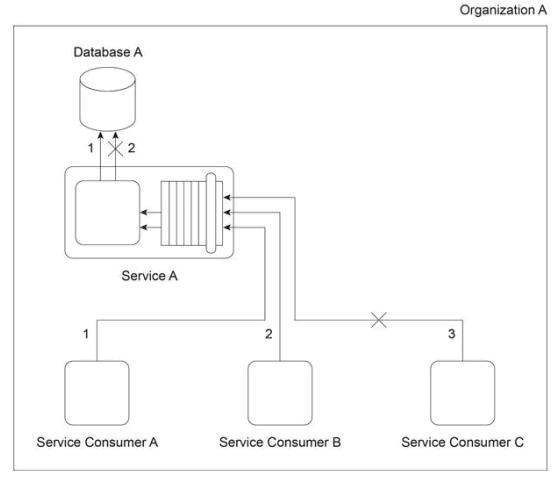
Organization A is required to continue using its on-premise Service A implementation, with the exception of Database A, which does not need to remain on-premise. Database A is dedicated to Service A and is comprised of relational data. Which of the following statements provides a solution that uses cloud-based IT resources to solve the performance limitations of Service A and Database A?
Correct : C
Start a Discussions
Cloud X (owned by Cloud Provider X) provides Physical Server A which hosts Virtual Servers A and B. Virtual Server B hosts Ready-Made Environments A and B . Cloud Service Consumer A uses Virtual Server A as part of an IaaS leasing agreement in which Cloud Consumer A is charged a fixed monthly fee for unlimited access. Cloud Service Consumers B and C use Ready-Made Environments A and B respectively as part of a PaaS leasing agreement based on per-minute usage fees. In both cases, access is monitored via Pay-For-Use Monitor A, which keeps track of log-in and log-out times in order to calculate the usage charges that are billed to Cloud Consumers B and C .
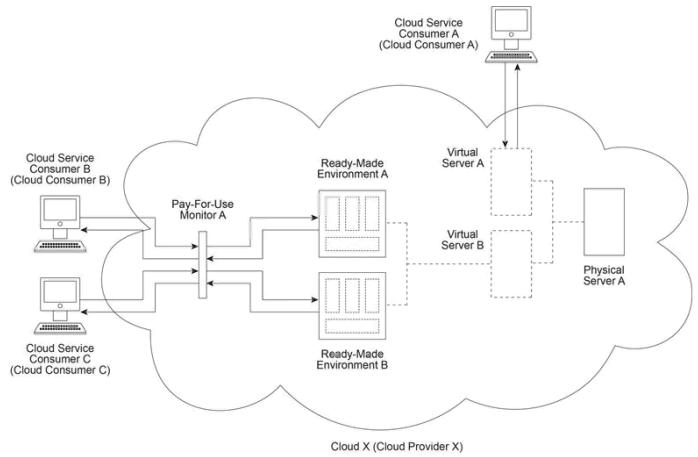
Physical Server A begins to become unstable. Over the course of a 24 hour period, the server shuts down three times, taking down Virtual Servers A and B with it. This causes numerous problems for Cloud Service Consumers A, B and C, which lose connections and encounter a variety of exceptions. A subsequent investigation of the log files generated by Pay-For-Use Monitor A reveals that the three server crashes coincided with the usage periods of Ready-Made Er n'ronment B b> Cloud Service Consumer B. De 'elopers at the Cloud Consumer 3 organization confirm they did not actually log in during those periods, which leads Cloud Provider X to discover that another cloud service consumer has been posing as Cloud Service Consumer B in order to maliciously access Ready-Made Environment B, Virtual Server B, and Physical Server B on Cloud X. The investigation concludes that the malicious cloud service consumer was able to carry out the attack successfully by obtaining a weak password being used by developers from Cloud Consumer B . Which of the following statements accurately identifies the type of security threat that corresponds to the described attack - and -provides a solution that can directly mitigate this type of security threat within Cloud X?
Correct : A
Start a Discussions
Cloud Provider X has deployed a virtualization environment in Cloud X comprised of Physical Server A hosting Virtual Servers A and B. Cloud Provider X implements Cloud Service A on Virtual Server A and makes it available to Cloud Service Consumer A, which interacts with Cloud Service A by sending and receiving messages (1, 2). Cloud Provider Y has deployed a virtualization environment comprised of Physical Server B hosting Virtual Servers C and D. Virtual Server C is made available to Cloud Service Consumer B, which interacts with Virtual Server C (3,4) in order to prepare for the deployment of a new cloud service that will be used internally by Cloud Provider Y to process data obtained from Cloud Service A .
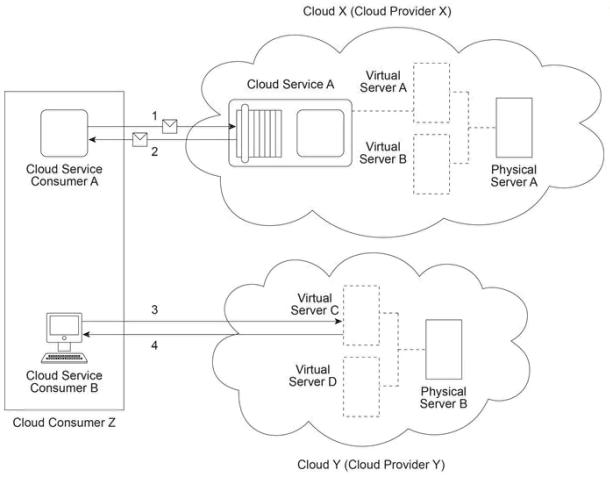
Cloud X is administered by a group of organizations and makes Cloud Service A available only to cloud service consumers from that group. Cloud Consumer Z belongs to one of the organizations within this group. Cloud Y and Cloud Consumer Z are owned by the same organization. Which of the following statements provides a valid scenario that accurately describes the involvement of cloud deployment models, cloud delivery models, roles and/or boundaries? (Note that the correct answer represents one of multiple valid scenarios that can exist.)
Correct : C
Start a Discussions
Cloud Service Consumer A accesses Cloud Service A (1) that resides in Cloud X. a private cloud owned by the same organization acting as Cloud Consumer A . Cloud Service A processes the message from Cloud Service Consumer A and then sends back a response with the requested data (2). Next, Cloud Service Consumer A sends a message containing some of this data to Cloud Service B (3), which resides in public Cloud Y that is owned by Cloud Provider Y. After processing the message, Cloud Service B sends back a response with additional data to Cloud Service Consumer A (4). Finally, Cloud Service Consumer A writes the data it collected from Cloud Services A and B to Database A (5).
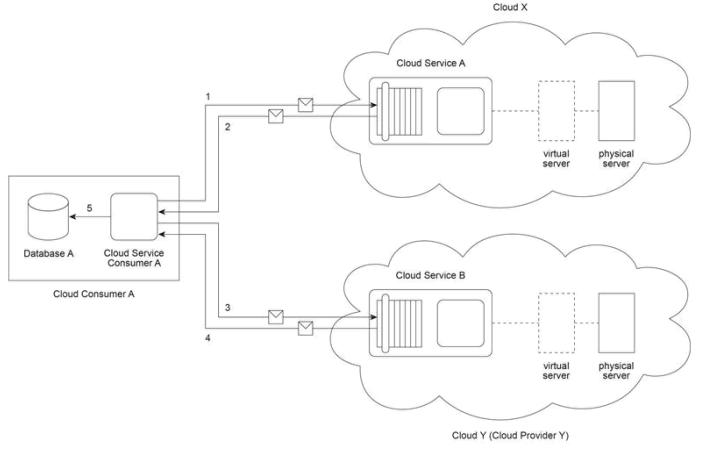
Recently, Cloud Service Consumer A has been required to access Cloud Services A and B at a significantly higher rate, sometimes over 1,000 times within a given workday. This increased usage has not affected Cloud Service B's performance. Cloud Service A, however, has been generating runtime exceptions and responses to Cloud Service Consumer A have become increasingly slow and unreliable. It is determined that this decline in performance is due to infrastructure limitations within private Cloud X's environment. Instead of investing in new infrastructure for Cloud X, it is decided to explore the feasibility of moving Cloud Service A to Cloud Y instead. Which of the following statements describe valid financial considerations that can be taken into account for assessing the feasibility of this move?
Correct : B, D
Start a Discussions
A cloud consumer is interested in leasing cloud-based virtual servers. It compares the virtual servers offered by Cloud Provider X and Cloud Provider Y. Cloud X (owned by Cloud Provider X) and Cloud Y (owned by Cloud Provider Y) both provide shared physical servers that host multiple virtual servers for other cloud consumers. The virtual servers on Cloud X are accessed directly, whereas the virtual servers on Cloud Y are accessed via an automated scaling listener. On Cloud X, virtual servers are pre-configured to support a specific amount of concurrent cloud service consumers. When this threshold is exceeded, cloud service consumer requests are rejected. Due to the use of the automated scaling listener, virtual servers on Cloud Y can provide a greater level of elasticity.
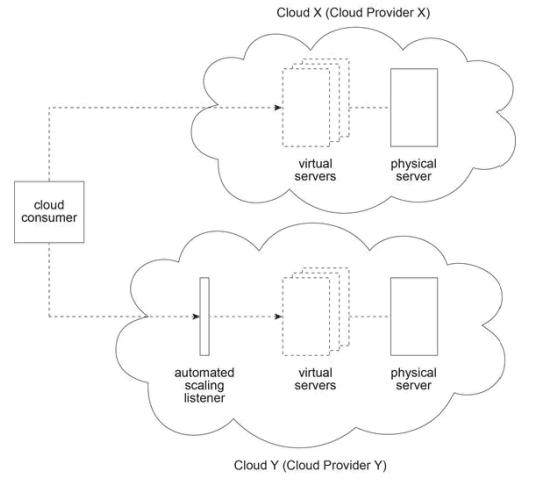
The hourly cost to the cloud consumer to use a virtual server on Cloud X is half that of the cost to use a virtual server on Cloud Y. Within a one month period, Cloud Provider X bases its hourly charge on the maximum number of virtual servers used. Within a one month period, Cloud Provider Y bases its hourly charges on actual virtual server usage. Cloud Provider Y charges $20 for each hour that a cloud consumer uses a virtual server. The cloud consumer predicts its monthly usage requirements to be as follows:
Number Of Virtual Servers
Usage
3
20 Hours
4
30 Hours
5
50 Hours
The cloud consumer is required to choose the cloud provider with the lowest on-going cost, based on its predicted usage. Which of the following statements accurately calculates the on-going usage costs of Cloud Providers X and Y and correctly states the cloud provider that the cloud consumer must choose?
Correct : D
Start a Discussions